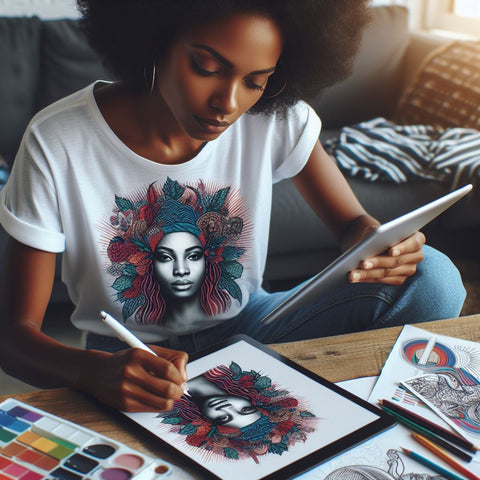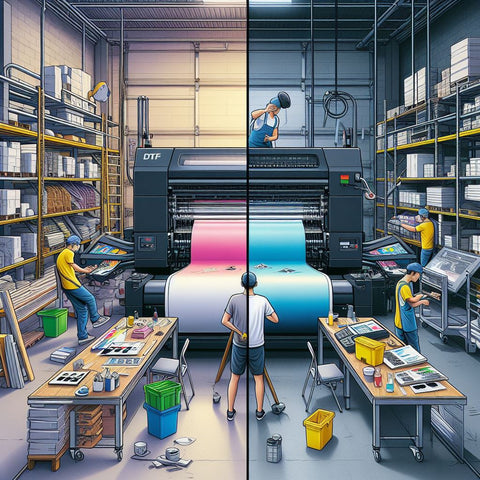When it comes to creating custom t-shirts or other apparel, direct to film (DTF) transfers have become an increasingly popular method. Offering vibrant and durable prints, DTF transfers provide a high-quality finish that is perfect for both personal and business use. However, to achieve the best results with DTF printing, it is essential to choose the right type of fabric. In this blog post, we will explore various fabric options that work well with DTF transfers and help you make an informed decision for your next project.
Cotton
Cotton is a versatile and widely used fabric that is compatible with DTF printing. It is known for its softness, breathability, and durability, making it an excellent choice for custom t-shirts. Cotton fabrics allow DTF transfers to adhere well and showcase vibrant colors. However, it is important to note that 100% cotton fabrics produce the best results with DTF prints compared to blended fabric options.
Polyester
Polyester is another popular fabric choice for DTF transfers. It is a synthetic material that offers several advantages, such as wrinkle resistance, quick-drying properties, and a smooth texture. Polyester fabrics are known to provide vibrant and long-lasting prints with DTF printing. Since polyester is a non-absorbent fabric, it allows the ink to sit on top rather than soaking in, resulting in excellent color saturation.
Blends
Blended fabrics, such as cotton-polyester blends, can also be used for DTF transfers. These fabrics combine the best of both worlds, offering the softness and breathability of cotton along with the wrinkle resistance and quick-drying properties of polyester. While DTF prints on blended fabrics may not be as vibrant as on 100% cotton or polyester, they still provide satisfactory results. It is essential to test a small piece of fabric before printing on a larger scale to ensure the desired outcome.
Spandex and Lycra
Spandex and Lycra are stretchy fabrics commonly used in athletic wear and other form-fitting garments. DTF transfers can be applied to spandex and Lycra fabrics, but it is important to handle them with care. These fabrics stretch, and excessive pulling or overstretching during the transfer process may lead to cracks or distortion in the print. To avoid such issues, it is recommended to stretch the fabric slightly while applying the transfer gently.
Rayon and Modal
Rayon and Modal are lightweight and breathable fabrics that are known for their excellent drape and softness. Although DTF transfers are possible on these fabrics, it is important to keep in mind that they absorb more ink compared to cotton or polyester. As a result, the prints may appear slightly muted or less vibrant. To mitigate this, it is advisable to use higher ink concentrations or opt for more vibrant colors when printing on rayon or modal fabrics.
Silk
Silk is a luxurious fabric that offers a smooth and lustrous finish. While DTF transfers can be applied to silk, it is crucial to exercise caution due to its delicate nature. Silk fabrics have a low tolerance for heat, so it is best to use a lower temperature when applying the transfer. Additionally, silk can be prone to water spotting, so it is important to ensure that all equipment and surfaces are dry during the printing process.
Canvas and Denim
Canvas and denim are sturdy and heavyweight fabrics that provide a unique texture and durability. DTF transfers can be successfully applied to both canvas and denim, offering long-lasting and bold prints. While the thick nature of these fabrics may require slightly longer transfer times, they provide excellent adhesion and vibrant color results. These fabrics are particularly popular for creating custom bags, jackets, and other durable products.
Fleece
Fleece is a cozy and warm fabric that is commonly used in jackets, blankets, and other cold-weather apparel. While DTF transfers can be applied to fleece fabrics, it is important to note that the texture of fleece may affect the level of detail in the print. The fuzzy surface of fleece may cause fine details to appear less defined. To mitigate this, it is recommended to use bold designs and larger lettering when printing on fleece fabrics.
Choosing the Right Fabric for Your Project
When it comes to selecting the right fabric for your DTF prints, it is essential to consider the specific requirements of your project. Here are some factors to keep in mind:
Intended Use
Think about how the finished product will be used. If it is a t-shirt for everyday wear, then cotton or cotton-polyester blends may be the best choice. If it is sportswear or athletic apparel, polyester fabrics would be more suitable.
Color Vibrancy
If vibrant colors are crucial for your design, opt for 100% cotton or polyester fabrics. Blended fabrics may produce slightly muted results, but they can still work well for many projects.
Fabric Texture
Consider the texture of the fabric and how it may affect the overall appearance of the print. Fabrics with a smooth texture, such as polyester, will showcase details more clearly, while textured fabrics like fleece may require bolder designs.
Printing Process
Each fabric may require specific print settings and handling techniques. Take into account the recommendations provided by your DTF printer manufacturer or supplier to ensure the best results.
Test Prints
Before embarking on a large-scale project, it is always a good idea to test prints on small fabric swatches. This will help you assess the compatibility of the fabric with DTF printing and make any necessary adjustments.
The Perfect Match for Your DTF Transfers
Choosing the right type of fabric for your DTF prints is crucial to achieving outstanding results. By considering factors such as fabric type, texture, color vibrancy, and printing process, you can select the perfect fabric for your project. Whether you opt for 100% cotton, polyester, blends, or other specialty fabrics like spandex or silk, understanding how each fabric interacts with DTF transfers will ensure that your final product meets or exceeds your expectations. So unleash your creativity, explore different fabric options, and create stunning custom apparel with DTF transfers!





Comments (0)
There are no comments for this article. Be the first one to leave a message!